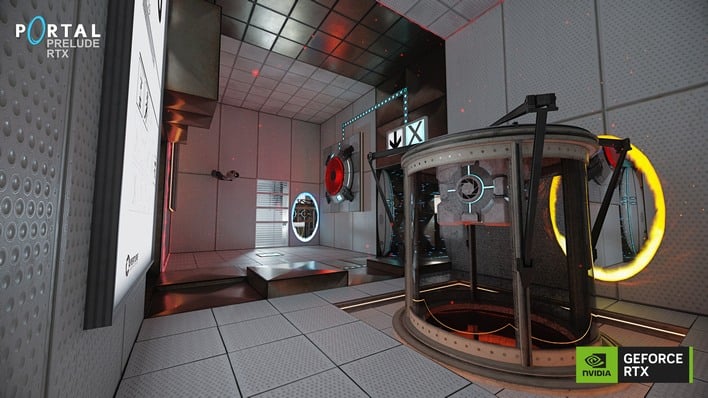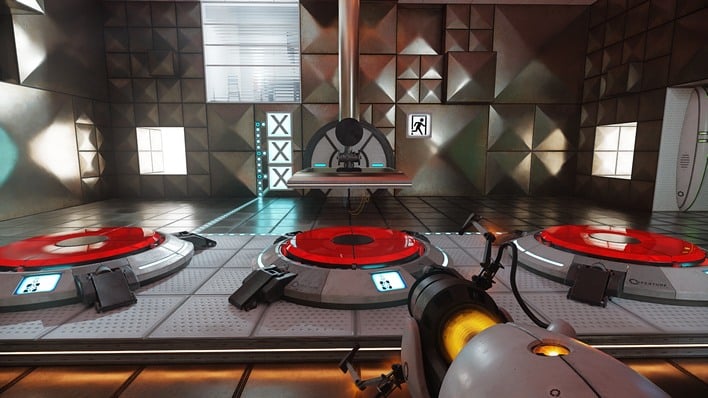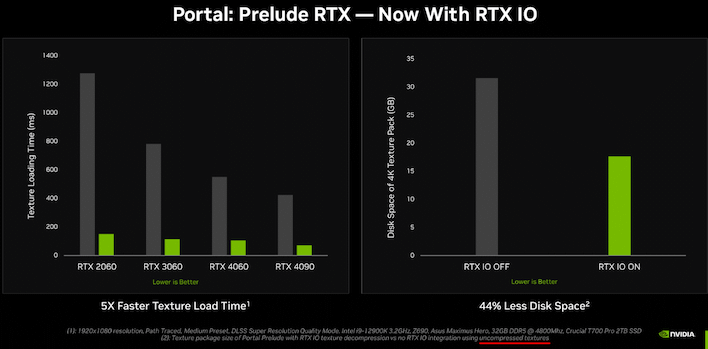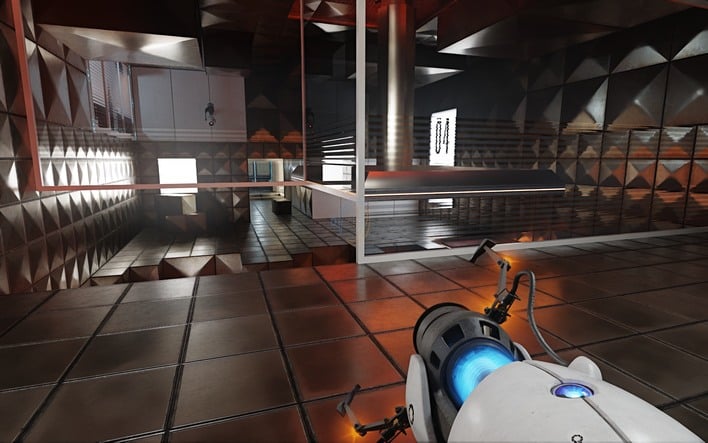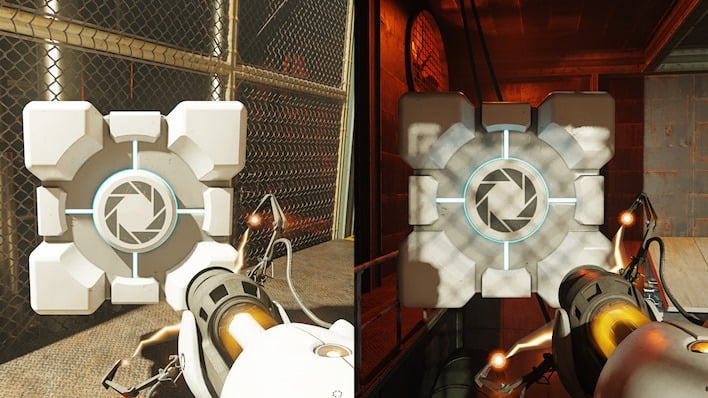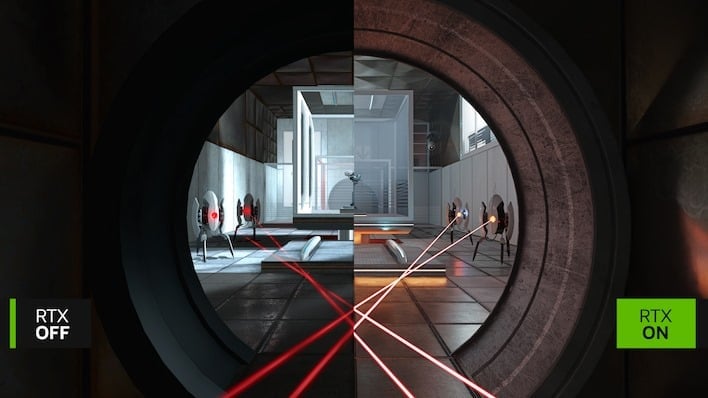NVIDIA's Load-Time Busting RTX IO Tested In Portal: Prelude RTX With DLSS 3
As a gamer, you sort-of get inured to loading time. It's largely unavoidable that games will, at some point, have periods where they have to say "please wait" and you can do little but twiddle your thumbs or maybe read some interesting load screen text while you wait for the engine to prepare the play environment.
It doesn't have to be that way anymore, though. Software stacks are finally catching up to hardware advancements, and disk accesses are being arranged in a way that suits solid-state storage instead of spinning rust hard drives. We've already seen some of the fruits of Microsoft's DirectStorage in the game Forspoken, but DirectStorage mandates the use of DirectX, which is limited to the Windows platform.
NVIDIA's RTX IO offers all of the benefits of DirectStorage, but it's uniquely available for use with the Vulkan API instead of just DirectX. That key difference allowed NVIDIA to implement it in the RTX Remix-enhanced Portal: Prelude RTX. This is arguably a mod of a mod of a mod—where Portal was essentially a mod of Half-Life 2, and Portal: Prelude was a mod of that, Portal: Prelude RTX is the exact same mod that was released in 2008, just with all of NVIDIA's latest graphics tech shoved inside.
Well, that's not strictly true. For starters, you can guess that the 2008 game didn't benefit from the incredibly-detailed models and high-resolution textures that you'll find in the RTX version. Likewise, there have been a few other changes, including the replacement of the original mod's comical-yet-charming text-to-speech voice-overs with quality vocal performances by real humans. There also were script changes to better suit modern sensibilities.
Portal: Prelude is a difficult mod meant for Portal speedrunners and other experts. Your author refers to it as "Kaizō Portal." Kaizō, written as 改造 in Japanese, simply means "remodeling" or "modification," but in the video game community it has come to refer to game mods or hacks that restructure the title with unfair challenges that require memorization to beat. That's exactly what you'll get from Portal: Prelude; the difficulty is insane and best suited to real Portal enjoyers who find beating their head against the wall part of the charm.
We're not here to talk about the game itself, though. Instead, we're interested in two things: the benefits of RTX IO, and the effects of the latest version of DLSS, including both DLSS upscaling (or "Super Resolution") as well as frame generation.
We've been testing Portal: Prelude RTX on a bleeding-edge Alienware m18 R1 laptop with a 13th-gen Intel Core i9 processor, a GeForce RTX 4090 laptop GPU, gobs of fast DDR5 memory, and a speedy PCIe 4.0 SSD. However, the non-RTX IO version of the game doesn't behave this way even on this beast. Loads take a few seconds, and you can catch glimpses of texture pop-in as you move around the Aperture Science test facilities. There are also noticeable loading hitches, particularly when entering a new level.

Using NVIDIA's new technology, the load before the main menu appears is slashed by 2/3rds, and every other load time, like when you click "New Game" or load a saved game, is best measured in milliseconds. You don't even have time to scratch your nose or crack your knuckles before you're in-game. It's wonderful, and it's how games should run.
Indeed, despite massive and razor-sharp 4K textures being streamed from disk to save memory, materials don't pop-in at all. In fact, where in many games you'll have little loading hitches as you traverse the environment, there's nothing of the sort in Portal: Prelude RTX with RTX IO enabled. Your framerate is determined entirely by how quickly your machine can render out fully ray-traced frames and nothing else.
Regardless, it makes for a tantalizing taste of the technology. While we did try DirectStorage 1.0 in Forspoken and appreciated its benefits to load time there, RTX IO in Portal: Prelude RTX has a feature that hasn't been implemented in any DirectStorage game yet, and that's GPU Decompression. We wrote about this in our announcement post for Portal: Prelude RTX, but basically, assets skip the CPU altogether and go straight from disk to system RAM, then to GPU RAM, all while compressed. Finally, they're decompressed on the GPU itself.
The result is incredibly-fast load times and basically-instant texture streaming, both of which are huge quality-of-life upgrades for PC gamers. We'll have to see how well the feature works in the upcoming PC port of Ratchet & Clank: Rift Apart, which is supposed to support DirectStorage 1.2 including GPU Decompression.

The reason for this is because it is fully ray-traced, or "path-traced"—all lighting calculations are done using ray-tracing, with nothing pre-calculated. The performance scales in a cubic fashion with screen resolution, so reducing the effective render resolution by using DLSS upscaling radically improves performance. On this mobile RTX 4090, enabling "Quality" upscaling and then turning on Frame Generation gives a perfectly playable experience with basically no artifacting that we could see.
If you don't mind things becoming a little softer visually, you can step down to the "Performance" preset for DLSS upscaling, but we actually saw higher frame rates with "Quality" and Frame Generation turned on than with "Performance" without. The reason for this is likely because the game is at times CPU-limited, or at least, very heavy on a few CPU threads.
In the screenshot above you can see the "CPU Max" says 93%. That's the highest utilization on a single thread at that moment. Even though the "CPU Total" usage says 18%, you have to remember that this is a 24-core CPU; almost no game is going to make use of all those threads. It's not talked about much, but ray-tracing is heavy on the CPU as well as the GPU, and that's why our Intel chip is heating up to 94ºC.
Our GPU usage is at 100%, so in this instance we're definitely GPU-limited. There are also times in Portal: Prelude RTX, though, that you can become CPU-limited, too—especially with DLSS "Performance" enabled. That's probably why DLSS 3 is so effective in this title: because the extra frames are generated entirely on the GPU, frame generation can let you work around a CPU bottleneck.
DLSS 3 Frame Generation offers a real benefit in this game that you're simply not going to get on a competing GPU. We haven't tested a Radeon RX 7900 XTX in this game, but we suspect it might offer similar performance—using NVIDIA Image Scaling, instead of DLSS—to the mobile RTX 4090 we tested. A 57 FPS average isn't awful, but it's barely half the potential performance of the AD103 GPU in this game.
Your author wasn't impressed with DLSS 3 Frame Generation at first. He originally experienced it in Cyberpunk 2077, where it incurred major input lag and stuttering issues. Some of those problems, bizarrely, were resolved in a BIOS update for his motherboard, but it turns out that Cyberpunk 2077 itself also had a bug where Ryzen processors specifically gave poor performance when using DLSS 3. After the firmware update and the game's 1.6.3 patch, DLSS 3 is a straight-up performance gain with no real downside in Cyberpunk 2077.
The same is true in Portal: Prelude RTX. Enabling NVIDIA's interpolation technology adds no felt input latency even compared to playing the game without DLSS 3 (but still with NVIDIA Reflex enabled) because the framerate goes up so much. There are no visible image quality problems, and you will quickly forget that you're playing an interpolated game. We still probably wouldn't use it for a twitch shooter just in case, but for just about any other genre of game, DLSS 3 Frame Generation is basically a net win for GeForce owners.
As far as Portal: Prelude RTX itself goes, well—like we said above, this game is not for the faint of heart. If you love Portal and aren't the type to get frustrated from repeated restarts, then there's a lot to like here. Anyone who isn't a Portal expert or willing to load their last autosave twenty-five times in every room should probably wait for the next RTX IO game to experience the instant load times it offers.
It doesn't have to be that way anymore, though. Software stacks are finally catching up to hardware advancements, and disk accesses are being arranged in a way that suits solid-state storage instead of spinning rust hard drives. We've already seen some of the fruits of Microsoft's DirectStorage in the game Forspoken, but DirectStorage mandates the use of DirectX, which is limited to the Windows platform.
NVIDIA's RTX IO offers all of the benefits of DirectStorage, but it's uniquely available for use with the Vulkan API instead of just DirectX. That key difference allowed NVIDIA to implement it in the RTX Remix-enhanced Portal: Prelude RTX. This is arguably a mod of a mod of a mod—where Portal was essentially a mod of Half-Life 2, and Portal: Prelude was a mod of that, Portal: Prelude RTX is the exact same mod that was released in 2008, just with all of NVIDIA's latest graphics tech shoved inside.
Well, that's not strictly true. For starters, you can guess that the 2008 game didn't benefit from the incredibly-detailed models and high-resolution textures that you'll find in the RTX version. Likewise, there have been a few other changes, including the replacement of the original mod's comical-yet-charming text-to-speech voice-overs with quality vocal performances by real humans. There also were script changes to better suit modern sensibilities.
Portal: Prelude is a difficult mod meant for Portal speedrunners and other experts. Your author refers to it as "Kaizō Portal." Kaizō, written as 改造 in Japanese, simply means "remodeling" or "modification," but in the video game community it has come to refer to game mods or hacks that restructure the title with unfair challenges that require memorization to beat. That's exactly what you'll get from Portal: Prelude; the difficulty is insane and best suited to real Portal enjoyers who find beating their head against the wall part of the charm.
We're not here to talk about the game itself, though. Instead, we're interested in two things: the benefits of RTX IO, and the effects of the latest version of DLSS, including both DLSS upscaling (or "Super Resolution") as well as frame generation.
RTX IO: Nixing Load Screens With NVMe SSDs
In a word, RTX IO is fantastic. You might not notice the difference when you load up the game because you're expecting a 2007-vintage game to launch and load instantaneously. However, in technical terms, this is solidly a 2023 video game, and the fact that it does launch and load essentially-instantly is very impressive.We've been testing Portal: Prelude RTX on a bleeding-edge Alienware m18 R1 laptop with a 13th-gen Intel Core i9 processor, a GeForce RTX 4090 laptop GPU, gobs of fast DDR5 memory, and a speedy PCIe 4.0 SSD. However, the non-RTX IO version of the game doesn't behave this way even on this beast. Loads take a few seconds, and you can catch glimpses of texture pop-in as you move around the Aperture Science test facilities. There are also noticeable loading hitches, particularly when entering a new level.
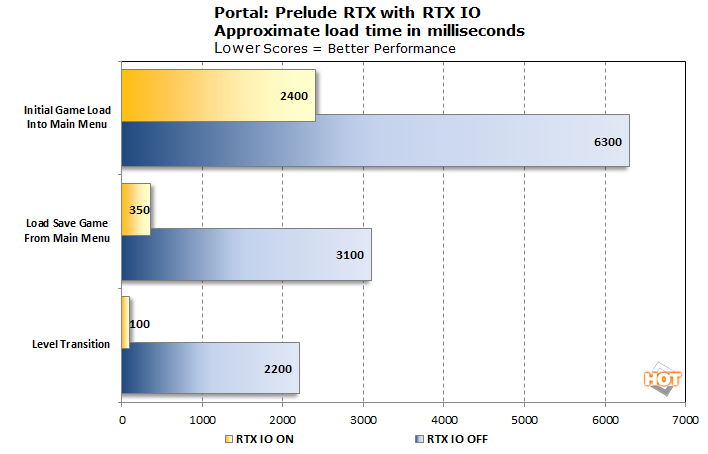
Using NVIDIA's new technology, the load before the main menu appears is slashed by 2/3rds, and every other load time, like when you click "New Game" or load a saved game, is best measured in milliseconds. You don't even have time to scratch your nose or crack your knuckles before you're in-game. It's wonderful, and it's how games should run.
Indeed, despite massive and razor-sharp 4K textures being streamed from disk to save memory, materials don't pop-in at all. In fact, where in many games you'll have little loading hitches as you traverse the environment, there's nothing of the sort in Portal: Prelude RTX with RTX IO enabled. Your framerate is determined entirely by how quickly your machine can render out fully ray-traced frames and nothing else.
(tap or click to enlarge)
NVIDIA crows not only about the load time savings of RTX IO, but also about the disk space savings. It's true that non-RTX IO version of the game is over 30 GB in size while the RTX IO-enabled branch is under 20 GB. However, we have to remark that this isn't exactly a fair comparison; the non-RTX IO branch is using uncompressed assets, while every retail game on the market—none of which use RTX IO—have compressed assets.
NVIDIA's choice to debut RTX IO in Portal: Prelude RTX is a strange one. It's a game that is mostly made up of tiny rooms that are usually completely empty save the player and perhaps a companion cube. RTX IO offers huge gains in this game, percentage-wise, but the real-time savings from the upgraded I/O stack are minimal because the game simply isn't doing that much loading—even handicapped with uncompressed assets.
Regardless, it makes for a tantalizing taste of the technology. While we did try DirectStorage 1.0 in Forspoken and appreciated its benefits to load time there, RTX IO in Portal: Prelude RTX has a feature that hasn't been implemented in any DirectStorage game yet, and that's GPU Decompression. We wrote about this in our announcement post for Portal: Prelude RTX, but basically, assets skip the CPU altogether and go straight from disk to system RAM, then to GPU RAM, all while compressed. Finally, they're decompressed on the GPU itself.
The result is incredibly-fast load times and basically-instant texture streaming, both of which are huge quality-of-life upgrades for PC gamers. We'll have to see how well the feature works in the upcoming PC port of Ratchet & Clank: Rift Apart, which is supposed to support DirectStorage 1.2 including GPU Decompression.
DLSS 3 Frame Generation: Saving Seriously Poor Performance
In case you missed it above, the system we're testing on is a powerful gaming laptop with a mobile GeForce RTX 4090. That processor is based on an AD103 GPU—the same chip found in the desktop GeForce RTX 4080, just with slightly lower clocks for the mobile form factor. It's a mighty GPU, competitive against or faster than anything on the market short of the desktop GeForce RTX 4090.
Despite that, trying to run Portal: Prelude RTX in the native 2560⨯1600 resolution of this system's built-in display is basically a no-go. You can turn on DLSS 3 Frame Generation, and it does help make the image look smoother, but without also using upscaling, it feels terrible because the game engine is still processing events at the pre-frame-generation rate and this comes through in your movement. You really need to use DLSS upscaling to make this game playable.
The reason for this is because it is fully ray-traced, or "path-traced"—all lighting calculations are done using ray-tracing, with nothing pre-calculated. The performance scales in a cubic fashion with screen resolution, so reducing the effective render resolution by using DLSS upscaling radically improves performance. On this mobile RTX 4090, enabling "Quality" upscaling and then turning on Frame Generation gives a perfectly playable experience with basically no artifacting that we could see.
If you don't mind things becoming a little softer visually, you can step down to the "Performance" preset for DLSS upscaling, but we actually saw higher frame rates with "Quality" and Frame Generation turned on than with "Performance" without. The reason for this is likely because the game is at times CPU-limited, or at least, very heavy on a few CPU threads.
In the screenshot above you can see the "CPU Max" says 93%. That's the highest utilization on a single thread at that moment. Even though the "CPU Total" usage says 18%, you have to remember that this is a 24-core CPU; almost no game is going to make use of all those threads. It's not talked about much, but ray-tracing is heavy on the CPU as well as the GPU, and that's why our Intel chip is heating up to 94ºC.
Our GPU usage is at 100%, so in this instance we're definitely GPU-limited. There are also times in Portal: Prelude RTX, though, that you can become CPU-limited, too—especially with DLSS "Performance" enabled. That's probably why DLSS 3 is so effective in this title: because the extra frames are generated entirely on the GPU, frame generation can let you work around a CPU bottleneck.
DLSS 3 Frame Generation offers a real benefit in this game that you're simply not going to get on a competing GPU. We haven't tested a Radeon RX 7900 XTX in this game, but we suspect it might offer similar performance—using NVIDIA Image Scaling, instead of DLSS—to the mobile RTX 4090 we tested. A 57 FPS average isn't awful, but it's barely half the potential performance of the AD103 GPU in this game.
Your author wasn't impressed with DLSS 3 Frame Generation at first. He originally experienced it in Cyberpunk 2077, where it incurred major input lag and stuttering issues. Some of those problems, bizarrely, were resolved in a BIOS update for his motherboard, but it turns out that Cyberpunk 2077 itself also had a bug where Ryzen processors specifically gave poor performance when using DLSS 3. After the firmware update and the game's 1.6.3 patch, DLSS 3 is a straight-up performance gain with no real downside in Cyberpunk 2077.
The same is true in Portal: Prelude RTX. Enabling NVIDIA's interpolation technology adds no felt input latency even compared to playing the game without DLSS 3 (but still with NVIDIA Reflex enabled) because the framerate goes up so much. There are no visible image quality problems, and you will quickly forget that you're playing an interpolated game. We still probably wouldn't use it for a twitch shooter just in case, but for just about any other genre of game, DLSS 3 Frame Generation is basically a net win for GeForce owners.
As far as Portal: Prelude RTX itself goes, well—like we said above, this game is not for the faint of heart. If you love Portal and aren't the type to get frustrated from repeated restarts, then there's a lot to like here. Anyone who isn't a Portal expert or willing to load their last autosave twenty-five times in every room should probably wait for the next RTX IO game to experience the instant load times it offers.

